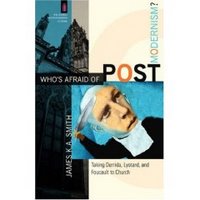Monday, November 13, 2006
Whose Afraid of Postmodernism? Part 1

We just recently finished a book by James K. A. Smith called Whose Afraid of Postmodernism? I highly recommend this book if you are interested in postmodernism and the implications that its philosophy might have for the future of the church. For the next five post I will be putting up chapter summaries that we were required to write. They are by no means exhaustive but they may give you a taste of some of the content of the book. Check it out!
Chapter One
Smith begins the chapter with the most pertinent question that one should ask when engaging this particular topic, that question being, “What is postmodernism?” I think that he is right to assert that the definition is somewhat a “nebulous concept-a slippery beast eluding our understanding.” I think this is partially due to the fact that we are dealing with a topic, concept or whatever you would like to call it, that no one has dealt with before. This is truly new ground.
Smith proposes two things to try to help us better formulate the concept. He first advocates a “return to the philosophy itself to understand postmodernity.” By “the philosophy”, Smith is referring to the popular French philosophers who are credited for the beginning processes of postmodernity. Three of these philosophers are to be engaged throughout the entirety of the book. They are Jacques Derrida, Jean-Francois Lyotard, and Michel Foucault.
Specifically, Smith intends to show how the church can “attempt to make off with postmodern loot for the sake of the kingdom.” By doing so, Smith will use Derrida’s insight to question “the centrality of Scripture for mediating our understanding of the world as a whole and the roles of community in the interpretation of Scripture.” Smith will use Lyotard’s insight to “recover the narrative character of Christian faith…and the confessional nature of our narrative and the way in which we find ourselves in a world of competing narratives.” Smith will use Foucault to push us to realize the “cultural power of formation and discipline, and hence the necessity of the church to enact counterformation by counterdisciplines.”
</DIV>Smith begins the chapter with the most pertinent question that one should ask when engaging this particular topic, that question being, “What is postmodernism?” I think that he is right to assert that the definition is somewhat a “nebulous concept-a slippery beast eluding our understanding.” I think this is partially due to the fact that we are dealing with a topic, concept or whatever you would like to call it, that no one has dealt with before. This is truly new ground.
Smith proposes two things to try to help us better formulate the concept. He first advocates a “return to the philosophy itself to understand postmodernity.” By “the philosophy”, Smith is referring to the popular French philosophers who are credited for the beginning processes of postmodernity. Three of these philosophers are to be engaged throughout the entirety of the book. They are Jacques Derrida, Jean-Francois Lyotard, and Michel Foucault.
Specifically, Smith intends to show how the church can “attempt to make off with postmodern loot for the sake of the kingdom.” By doing so, Smith will use Derrida’s insight to question “the centrality of Scripture for mediating our understanding of the world as a whole and the roles of community in the interpretation of Scripture.” Smith will use Lyotard’s insight to “recover the narrative character of Christian faith…and the confessional nature of our narrative and the way in which we find ourselves in a world of competing narratives.” Smith will use Foucault to push us to realize the “cultural power of formation and discipline, and hence the necessity of the church to enact counterformation by counterdisciplines.”